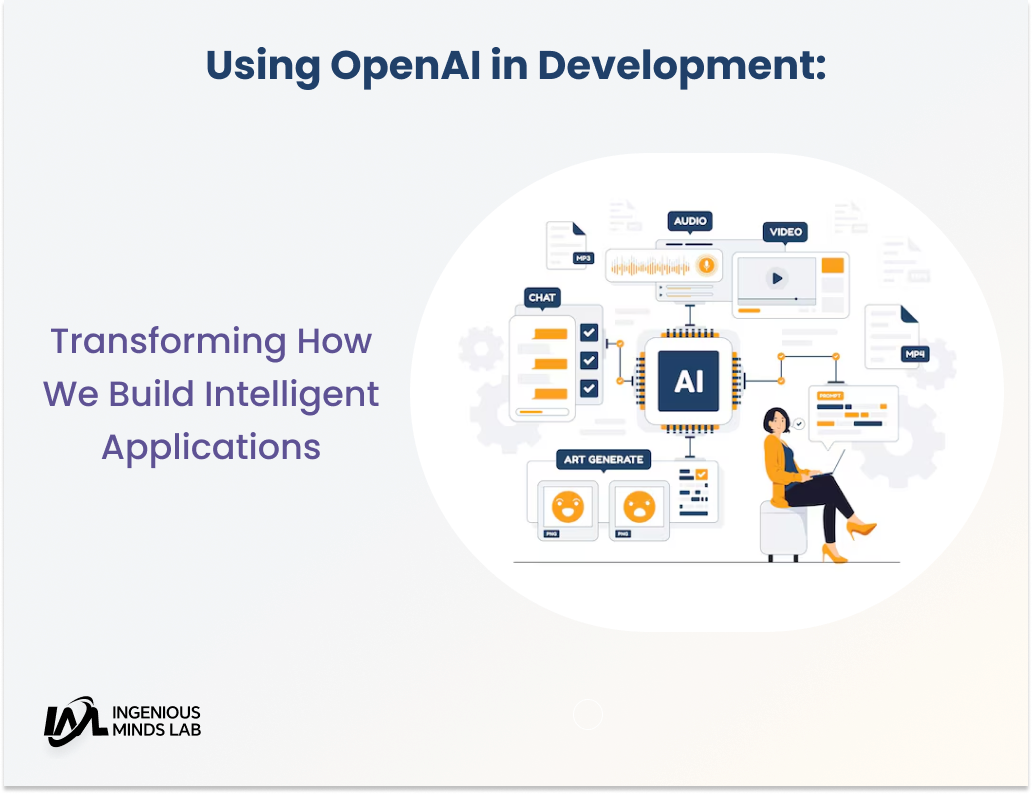Using OpenAI in Development: Transforming How We Build Intelligent Applications
Artificial Intelligence is no longer just a buzzword—it’s a game-changing force that’s being integrated into the heart of modern software development. At the forefront of this movement is OpenAI, a powerful platform that’s empowering developers to create more intelligent, adaptive, and user-friendly applications.
Whether you’re building a chatbot, an AI writing assistant, a code review tool, or automating business workflows, using OpenAI in development can unlock new capabilities and radically improve how your applications function.
In this blog, we’ll explore what OpenAI offers, how to integrate it into development workflows, and real-world use cases transforming industries.
🤖 What Is OpenAI?
OpenAI is an AI research and deployment company behind some of the world’s most advanced language models, including ChatGPT, GPT-4, Codex, and DALL·E. These models can understand and generate human-like text, write code, answer questions, and even create images—making them incredibly useful across a wide range of development use cases.
Developers can access OpenAI’s models via APIs, making it easy to embed powerful natural language understanding and generation into their own software.
🛠️ How Developers Use OpenAI in Development
✅ 1. Building Chatbots and Virtual Assistants
By using OpenAI’s ChatGPT models, developers can create conversational interfaces that are intelligent, context-aware, and capable of natural language understanding.
Use cases:
Customer support bots
In-app help assistants
Educational tutors
✅ 2. Content Generation
OpenAI can be used to generate blog posts, social media captions, product descriptions, and more. This is especially useful for content platforms and marketing tools.
Use cases:
SEO content automation
Email personalization
AI-powered copywriting tools
✅ 3. Code Generation and Review
With OpenAI Codex, developers can automate boilerplate code, generate functions, and even receive suggestions or documentation for their codebase.
Use cases:
Auto-complete for code editors
API generation from plain text
Commenting and documentation automation
✅ 4. Data Analysis and Summarization
OpenAI can summarize documents, extract key insights, or convert structured data into readable explanations—making it perfect for dashboard applications or BI tools.
Use cases:
Report summarization
Log analysis
Customer feedback processing
✅ 5. Translation and Localization
Using OpenAI’s multilingual capabilities, developers can build translation tools or localize app content across multiple languages with natural fluency.
Use cases:
Real-time translation in chat apps
Localized customer support
E-commerce product listing translations
📈 Benefits of Using OpenAI in Development
✔ Enhanced User Experience
Natural, conversational interfaces lead to better customer engagement and satisfaction.
✔ Reduced Development Time
OpenAI can help automate repetitive tasks like code writing, content creation, or summarization, freeing up developers to focus on complex features.
✔ Scalable Intelligence
Instead of building complex NLP systems from scratch, developers can tap into OpenAI’s APIs for instant, high-quality results.
✔ Versatile Use Cases
From small startups to large enterprises, OpenAI supports diverse applications in finance, education, healthcare, and beyond.
✔ Competitive Edge
Embedding AI features into apps helps products stand out and meet modern user expectations.
🧠 Real-World Examples
🔹 Notion AI
Notion uses OpenAI to help users summarize notes, write emails, and brainstorm ideas within their workspace.
🔹 GitHub Copilot
Built using OpenAI Codex, Copilot provides real-time code suggestions and auto-completions inside your code editor.
🔹 Duolingo Max
Duolingo integrates OpenAI to create more conversational learning experiences with AI-powered roleplays and explanations.
🔹 Zapier AI Actions
Zapier uses OpenAI to let users write natural-language prompts to automate workflows—no code required.
🌍 Industries Benefiting from OpenAI Integration
| Industry | Use Case |
|---|---|
| E-commerce | Personalized shopping assistants, product descriptions |
| Finance | Report summarization, customer chatbots |
| Healthcare | Patient Q&A systems, summarizing medical records |
| Education | Homework helpers, content creation, interactive tutors |
| SaaS Platforms | AI-assisted document editing, email drafting |
🔄 Challenges and Considerations
While using OpenAI in development offers numerous benefits, developers should be aware of certain limitations:
Cost Management: Heavy usage of OpenAI APIs can become expensive at scale.
Output Reliability: AI-generated content may occasionally be inaccurate or biased.
Latency: Real-time use cases may require caching or optimization.
Ethical Use: Ensure your app doesn’t mislead users into thinking AI is human.
🔮 The Future of AI in Development
OpenAI continues to innovate with models like GPT-4, image generation (DALL·E), and multimodal capabilities. As these tools become more powerful and accessible, developers will be able to create even more intelligent, personalized, and dynamic applications.
Upcoming advancements include:
Real-time voice and image interactions
Embedded AI copilots in every major platform
Fine-tuned models for niche business tasks
Deeper integration with cloud, edge, and on-device AI
📌 Final Thoughts
Using OpenAI in development is transforming how we build modern applications—from smarter customer support to automated content and intelligent coding assistants. Whether you’re working on a startup MVP or scaling enterprise software, OpenAI’s tools provide unmatched flexibility and power.
With the right strategy and ethical considerations, developers can build future-ready apps that not only solve problems—but do so intelligently and intuitively.
❓Frequently Asked Questions
Q1: How do I start using OpenAI in my app?
Sign up at OpenAI, get an API key, and use their docs to call models like ChatGPT or Codex via HTTP requests.
Q2: Is OpenAI free to use?
OpenAI offers limited free usage. After that, it’s pay-as-you-go based on usage (tokens consumed).
Q3: Can OpenAI write code for my app?
Yes! With Codex, OpenAI can generate code snippets, full functions, or even explain complex programming logic.

